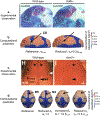A coupled reaction-diffusion-strain model predicts cranial vault formation in development and disease
- PMID: 31006064
- PMCID: PMC6625897
- DOI: 10.1007/s10237-019-01139-z
A coupled reaction-diffusion-strain model predicts cranial vault formation in development and disease
Abstract
How cells utilize instructions provided by genes and integrate mechanical forces generated by tissue growth to produce morphology is a fundamental question of biology. Dermal bones of the vertebrate cranial vault are formed through the direct differentiation of mesenchymal cells on the neural surface into osteoblasts through intramembranous ossification. Here we join a self-organizing Turing mechanism, computational biomechanics, and experimental data to produce a 3D representative model of the growing cerebral surface, cranial vault bones, and sutures. We show how changes in single parameters regulating signaling during osteoblast differentiation and bone formation may explain cranial vault shape variation in craniofacial disorders. A key result is that toggling a parameter in our model results in closure of a cranial vault suture, an event that occurred during evolution of the cranial vault and that occurs in craniofacial disorders. Our approach provides an initial and important step toward integrating biomechanics into the genotype phenotype map to explain the production of variation in head morphology by developmental mechanisms.
Keywords: Brain; Computational morphogenesis; Craniosynostosis; Finite volume method; Intramembranous ossification; Mouse model; Skull growth and evolution.
Figures







References
-
- Aldridge K, Hill CA, Austin JR, Percival C, Martinez-Abadias N, Neuberger T, Wang Y, Jabs EW, Richtsmeier JT (2010) Brain phenotypes in two FGFR2 mouse models for Apert syndrome. Developmental dynamics : an official publication of the American Association of Anatomists 239(3):987–997, DOI 10.1002/dvdy.22218 - DOI - PMC - PubMed
-
- Carroll S, Grenier J, Weatherbee S (2004) From DNA to diversity: molecular genetics and the evolution of animal design Blackwell Publishers, DOI 10.1093/jhered/esi101 - DOI
MeSH terms
Grants and funding
LinkOut - more resources
Full Text Sources
Medical

